Transform Your Business with AI Workflow Automation Development
Transform Your Business with AI Workflow Automation Development
Transform Your Business with AI Workflow Automation Development
Supercharge your business efficiency with AI! This guide explores how AI workflow automation development can streamline tasks, reduce costs, and boost productivity.
Supercharge your business efficiency with AI! This guide explores how AI workflow automation development can streamline tasks, reduce costs, and boost productivity.
Supercharge your business efficiency with AI! This guide explores how AI workflow automation development can streamline tasks, reduce costs, and boost productivity.
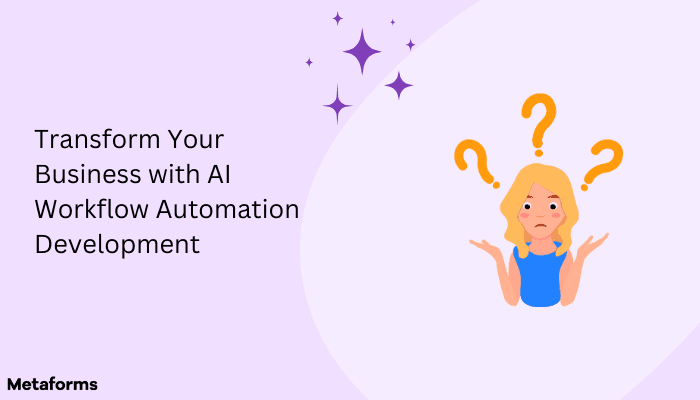


We all have 24 hours in a day. But why does it feel like some businesses achieve ten times more? The answer: AI workflow automation.
For instance, say you run a small marketing agency. You spend countless hours sending personalized emails, scheduling social media posts, and generating reports every week. These repetitive tasks waste valuable time that could be spent crafting brilliant marketing campaigns.
AI workflow automation can be your game-changer. It's like having a tireless digital assistant who automates these repetitive tasks, freeing you to focus on what truly matters - growing your business.
That's exactly what AI workflow automation does. It uses artificial intelligence (AI), basically super-smart computer technology, to automate repetitive tasks in your business processes.
Think of it like this: you teach the AI how to do something once, and then it can do it repeatedly, flawlessly and much faster than you ever could.
Introduction to AI Workflow Automation Development:

With AI Workflow, think about the extra hours you could reclaim – hours you could dedicate to brainstorming brilliant ideas, strategizing for exponential growth, or finally tackling that project that's been gathering dust.
You can achieve a soaring productivity, flawless accuracy and a happier, more engaged workforce. This translates to a business that operates at peak efficiency, outpaces the competition, and thrives in today's dynamic market.
This transition from manual tasks to AI-driven processes is surprisingly smooth. Many user-friendly AI workflow automation tools require no coding knowledge.
AI workflow automation isn't a new concept, but with technological advancements, it's becoming increasingly powerful and accessible. As computers become faster and more sophisticated, AI can learn and adapt more quickly, making it even more effective at automating tasks.
The recent pandemic situation has also highlighted the importance of automation. With many businesses facing remote workforces and disruptions, AI workflow automation has proven to be a valuable tool for maintaining productivity and efficiency. By automating repetitive tasks, businesses can ensure smooth operations even when faced with challenges.
Traditional Vs AI-driven workflow automation:
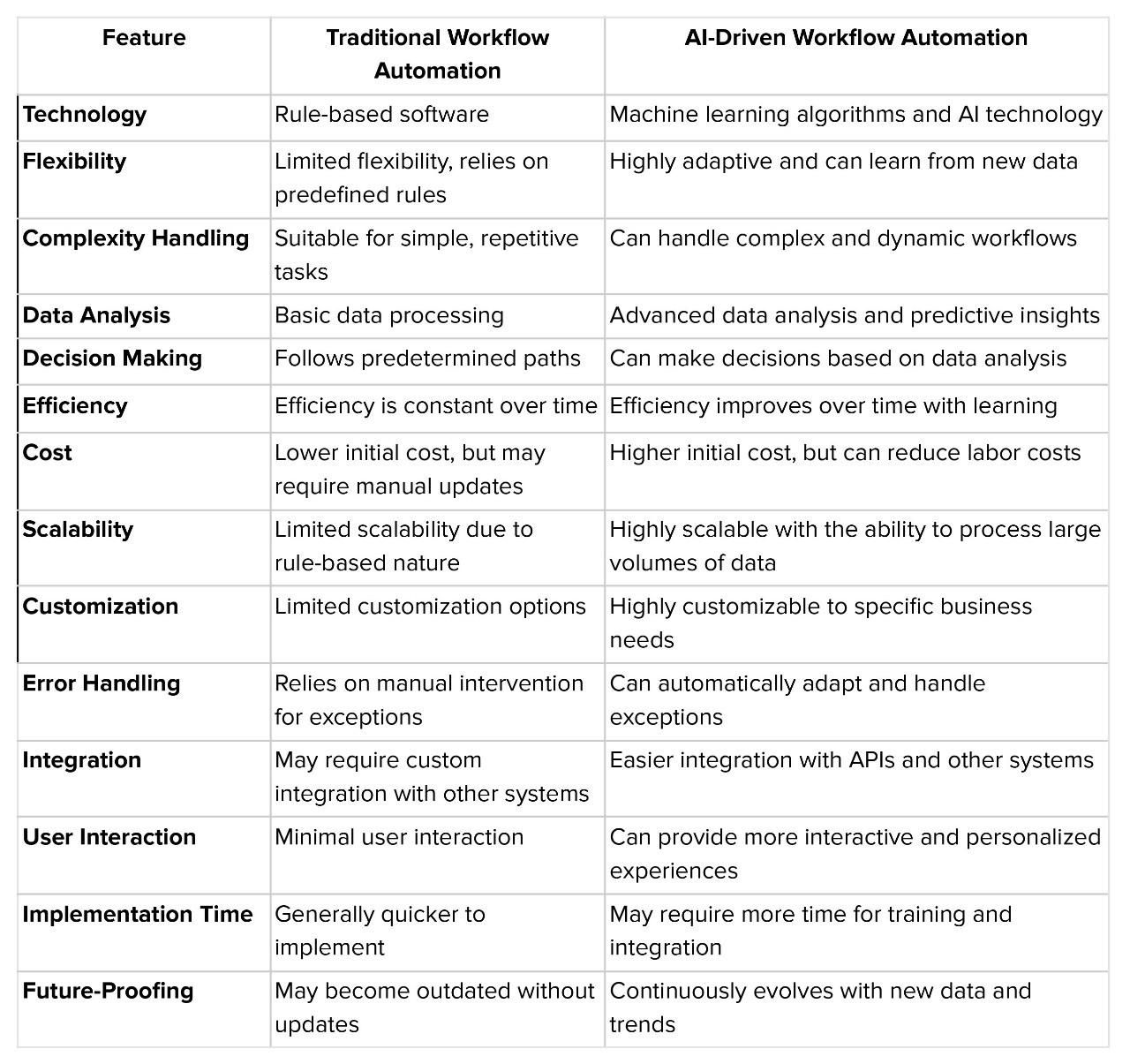
Traditional Workflow Automation
Traditional workflow automation tools rely on pre-programmed rules and logic to automate tasks. Think of it like a well-trained employee who follows a detailed instruction manual. Here's what you can expect:
Strengths:
Reliable for well-defined tasks: Once programmed correctly, traditional automation can execute repetitive tasks flawlessly.
Cost-effective for simple workflows: Setting up basic workflows can be relatively straightforward and cost-efficient.
Easy to maintain: Maintaining pre-programmed rules is generally less complex.
Weaknesses:
Limited flexibility: Adapting to changing workflows or unforeseen situations requires manual intervention and reprogramming.
Reliance on technical expertise: Setting up complex workflows might require programming knowledge.
Limited learning capability: Traditional automation can't learn from experience or improve workflows on its own.
AI-Driven Workflow Automation
AI workflow automation takes automation to the next level by incorporating artificial intelligence. It can learn and improve over time. Here's how AI changes the game:
Strengths:
Intelligent and adaptable: AI can learn from past experiences and adjust to new situations, automating tasks even in dynamic environments.
Continuous improvement: AI continuously analyzes data to identify new automation opportunities, streamlining workflows over time.
Scalability for growing businesses: AI automation effortlessly scales to accommodate increasing workload as your business grows.
User-friendly interfaces: Many AI automation tools are designed with user-friendly interfaces, making them accessible even without coding knowledge.
Weaknesses:
Potentially higher initial cost: Advanced AI features might come with a higher initial investment compared to basic automation tools.
Data dependency: AI relies on clean, organized data to function effectively. Data orchestration might be necessary.
AI thrives on clean data! Think of it as the fuel for your AI assistant. Data orchestration seamlessly integrates data from various sources, ensuring your AI can automate tasks accurately.
Benefits of Implementing AI Workflow Automation

1. Increased Productivity:
AI handles all those repetitive tasks that take up a significant chunk of your day. This frees up valuable time for you to focus on growing your business.
An e-commerce business, for example, can use AI to automatically process customer orders, freeing up employees to focus on providing excellent customer service.
2. Reduced Errors:
Human error is inevitable, but it can lead to delays and mistakes. AI, on the other hand, is incredibly precise. It can handle tasks with perfect accuracy, ensuring everything is done correctly the first time.
In a hospital setting, AI can automate tasks like scheduling appointments and managing patient records, minimizing errors and ensuring efficient patient care.
3. Improved Employee Morale:
Repetitive tasks can be tedious and uninspiring. By using AI to automate them, you can free up your team to focus on more creative and engaging work. This can lead to a happier and more motivated workforce, which translates to better overall performance.
A marketing agency, for example, can use AI to automate social media posting, allowing their team members to focus on developing innovative marketing campaigns.
4. Enhanced Efficiency:
AI can analyze your business processes and identify areas for improvement. It can then automate repetitive tasks and streamline workflows, leading to increased efficiency.
A manufacturing company can use AI to automate tasks like inventory management and quality control, ensuring smooth production and reducing costs.
5. Gaining a Competitive Edge:
In today's competitive business environment, efficiency is key. By using AI workflow automation, you can streamline your operations and become more efficient than your competitors. This allows you to respond to customer inquiries faster, complete projects quicker, and ultimately, achieve greater success.
Core Features of An Effective AI Workflow Automation Tool
Not all AI workflow automation tools are created equal! Choosing the right AI workflow automation tool for your business is crucial. Here are some key features to consider:
Ease of Use and Low-Code/No-Code Capabilities: Look for a tool that is user-friendly and doesn't require extensive coding knowledge. Ideally, the tool should have a drag-and-drop interface or visual builders that allow you to easily define workflows.
Integration with Existing Systems and Software Tools: Ensure the AI tool can seamlessly integrate with your existing business systems like CRM, ERP, and marketing automation platforms. This allows for a smooth flow of data and avoids the need for manual data entry.
Scalability to Fit Business Growth and Changing Needs: Your business needs will evolve over time. Choose a tool that can scale to accommodate increasing workload and adapt to changing workflows.
Budget-Friendliness and Achieving Strong Return on Investment (ROI): While AI offers immense value, consider your budget. Look for a tool that offers flexible pricing options and can demonstrate a strong return on investment (ROI) by streamlining your operations and freeing up your workforce.
Types of AI Workflow Automation Technologies
AI workflow automation isn't a one-size-fits-all solution. There are different types of AI technologies that can be used to automate tasks, each with its own strengths:
1. Predictive Analytics
Imagine a tool that can predict future trends and patterns based on data analysis. That's the power of predictive analytics! This type of AI can be used to automate tasks like forecasting sales or identifying potential customer churn (when a customer stops using your service). You can streamline your operations and make data-driven decisions by anticipating future needs.
2. Cognitive Automation
Cognitive automation takes AI a step further by mimicking human decision-making processes. It uses advanced algorithms to analyze complex data, identify patterns, and even make recommendations. For example, cognitive automation can be used to automate tasks like reviewing loan applications or analyzing customer sentiment on social media.
3. Rules-Based Automation
Rules-based automation is the perfect fit for well-defined, repetitive tasks with clear rules. This type of AI follows pre-programmed instructions to automate tasks. Think of it like a highly efficient robot following a detailed recipe. Examples include data entry, sending automatic reminders, or generating basic reports.
By understanding these different types of AI workflow automation technologies, you can choose the right tool for the job and unlock the full potential of AI in your business.
Real-World Application and Use Case:
Forward-thinking companies are embracing AI workflow automation to unlock a new level of productivity. Gartner research shows AI chatbots and virtual assistants can handle a whopping 80% of routine customer inquiries. Not just that, it also increases the overall productivity!
These companies are transforming the way they work by automating repetitive tasks, freeing up employees to focus on higher-value activities. Let's explore how companies conquer customer service with AI chatbots.
AI chatbots act like tireless customer service reps, available 24/7 to answer questions, troubleshoot problems, and handle routine inquiries. These chatbots can handle routine inquiries, answer frequently asked questions, and even troubleshoot basic problems.
This frees up your human customer service team to focus on complex issues and provide personalized support. For example, an e-commerce store can use an AI chatbot to answer questions about product availability, order tracking, or return policies.
This allows customer service reps to focus on resolving more complex issues or providing personalized recommendations.
Choosing the Right AI Workflow Automation Software:
Equipping your business with the right AI workflow automation software is like finding the perfect key to unlock a treasure trove of efficiency. To help you choose the most effective tool, here's your essential checklist:
1. Decoding Your Needs:
Identify the repetitive tasks and workflows that are prime candidates for automation. Where can AI take the biggest workload off your team's shoulders?
Consider your industry and specific business goals. What unique challenges can AI help you overcome?
2. Comparing Features and Functionality
Research leading AI tools and compare their capabilities. Look for features that address your specific needs, like document processing, data analysis, or customer service automation.
Don't get bogged down by complexity! Choose a tool with a user-friendly interface that allows your team to embrace AI without extensive training.
AI shouldn't break the bank. Evaluate pricing plans and choose a tool that offers good value for your investment.
3. Integration
Ensure the AI tool can seamlessly integrate with your existing business software—your CRM, ERP, and marketing platforms. This will avoid data entry headaches and create a smooth workflow.
Consider how the AI tool handles data security and privacy. Make sure your data stays protected and compliant with regulations.
4. Support System: Your AI Ally
Look for a platform with robust user support. A reliable support team can help implement, troubleshoot, and get the most out of your AI tool.
Future of AI Workflow Automation:
The future of AI workflow automation is brimming with possibilities and poised to revolutionize the way businesses operate. Here's a glimpse of what's on the horizon:
Evolving Landscape: AI capabilities will become even more sophisticated, automating repetitive tasks and complex processes that require analysis and decision-making.
A study by McKinsey Global Institute estimates that AI could potentially increase global productivity by up to 1.5% annually by 2030
Imagine AI not just processing invoices but also identifying areas for cost savings or predicting customer churn (when a customer stops using your service).
AI-Driven Decisions: AI will be central in analyzing vast data and recommending optimal processes. Businesses will leverage AI insights to make data-driven decisions that optimize workflows, improve resource allocation, and drive growth. Gartner research suggests that by 2024, 40% of data analytics tasks will be automated using AI and machine learning.
Continuous Evolution: AI tools will continuously evolve alongside advancements in technology. As machine learning algorithms become more powerful and new technologies emerge, AI workflows will adapt and integrate seamlessly, ensuring businesses remain at the forefront of innovation.
We all have 24 hours in a day. But why does it feel like some businesses achieve ten times more? The answer: AI workflow automation.
For instance, say you run a small marketing agency. You spend countless hours sending personalized emails, scheduling social media posts, and generating reports every week. These repetitive tasks waste valuable time that could be spent crafting brilliant marketing campaigns.
AI workflow automation can be your game-changer. It's like having a tireless digital assistant who automates these repetitive tasks, freeing you to focus on what truly matters - growing your business.
That's exactly what AI workflow automation does. It uses artificial intelligence (AI), basically super-smart computer technology, to automate repetitive tasks in your business processes.
Think of it like this: you teach the AI how to do something once, and then it can do it repeatedly, flawlessly and much faster than you ever could.
Introduction to AI Workflow Automation Development:

With AI Workflow, think about the extra hours you could reclaim – hours you could dedicate to brainstorming brilliant ideas, strategizing for exponential growth, or finally tackling that project that's been gathering dust.
You can achieve a soaring productivity, flawless accuracy and a happier, more engaged workforce. This translates to a business that operates at peak efficiency, outpaces the competition, and thrives in today's dynamic market.
This transition from manual tasks to AI-driven processes is surprisingly smooth. Many user-friendly AI workflow automation tools require no coding knowledge.
AI workflow automation isn't a new concept, but with technological advancements, it's becoming increasingly powerful and accessible. As computers become faster and more sophisticated, AI can learn and adapt more quickly, making it even more effective at automating tasks.
The recent pandemic situation has also highlighted the importance of automation. With many businesses facing remote workforces and disruptions, AI workflow automation has proven to be a valuable tool for maintaining productivity and efficiency. By automating repetitive tasks, businesses can ensure smooth operations even when faced with challenges.
Traditional Vs AI-driven workflow automation:

Traditional Workflow Automation
Traditional workflow automation tools rely on pre-programmed rules and logic to automate tasks. Think of it like a well-trained employee who follows a detailed instruction manual. Here's what you can expect:
Strengths:
Reliable for well-defined tasks: Once programmed correctly, traditional automation can execute repetitive tasks flawlessly.
Cost-effective for simple workflows: Setting up basic workflows can be relatively straightforward and cost-efficient.
Easy to maintain: Maintaining pre-programmed rules is generally less complex.
Weaknesses:
Limited flexibility: Adapting to changing workflows or unforeseen situations requires manual intervention and reprogramming.
Reliance on technical expertise: Setting up complex workflows might require programming knowledge.
Limited learning capability: Traditional automation can't learn from experience or improve workflows on its own.
AI-Driven Workflow Automation
AI workflow automation takes automation to the next level by incorporating artificial intelligence. It can learn and improve over time. Here's how AI changes the game:
Strengths:
Intelligent and adaptable: AI can learn from past experiences and adjust to new situations, automating tasks even in dynamic environments.
Continuous improvement: AI continuously analyzes data to identify new automation opportunities, streamlining workflows over time.
Scalability for growing businesses: AI automation effortlessly scales to accommodate increasing workload as your business grows.
User-friendly interfaces: Many AI automation tools are designed with user-friendly interfaces, making them accessible even without coding knowledge.
Weaknesses:
Potentially higher initial cost: Advanced AI features might come with a higher initial investment compared to basic automation tools.
Data dependency: AI relies on clean, organized data to function effectively. Data orchestration might be necessary.
AI thrives on clean data! Think of it as the fuel for your AI assistant. Data orchestration seamlessly integrates data from various sources, ensuring your AI can automate tasks accurately.
Benefits of Implementing AI Workflow Automation

1. Increased Productivity:
AI handles all those repetitive tasks that take up a significant chunk of your day. This frees up valuable time for you to focus on growing your business.
An e-commerce business, for example, can use AI to automatically process customer orders, freeing up employees to focus on providing excellent customer service.
2. Reduced Errors:
Human error is inevitable, but it can lead to delays and mistakes. AI, on the other hand, is incredibly precise. It can handle tasks with perfect accuracy, ensuring everything is done correctly the first time.
In a hospital setting, AI can automate tasks like scheduling appointments and managing patient records, minimizing errors and ensuring efficient patient care.
3. Improved Employee Morale:
Repetitive tasks can be tedious and uninspiring. By using AI to automate them, you can free up your team to focus on more creative and engaging work. This can lead to a happier and more motivated workforce, which translates to better overall performance.
A marketing agency, for example, can use AI to automate social media posting, allowing their team members to focus on developing innovative marketing campaigns.
4. Enhanced Efficiency:
AI can analyze your business processes and identify areas for improvement. It can then automate repetitive tasks and streamline workflows, leading to increased efficiency.
A manufacturing company can use AI to automate tasks like inventory management and quality control, ensuring smooth production and reducing costs.
5. Gaining a Competitive Edge:
In today's competitive business environment, efficiency is key. By using AI workflow automation, you can streamline your operations and become more efficient than your competitors. This allows you to respond to customer inquiries faster, complete projects quicker, and ultimately, achieve greater success.
Core Features of An Effective AI Workflow Automation Tool
Not all AI workflow automation tools are created equal! Choosing the right AI workflow automation tool for your business is crucial. Here are some key features to consider:
Ease of Use and Low-Code/No-Code Capabilities: Look for a tool that is user-friendly and doesn't require extensive coding knowledge. Ideally, the tool should have a drag-and-drop interface or visual builders that allow you to easily define workflows.
Integration with Existing Systems and Software Tools: Ensure the AI tool can seamlessly integrate with your existing business systems like CRM, ERP, and marketing automation platforms. This allows for a smooth flow of data and avoids the need for manual data entry.
Scalability to Fit Business Growth and Changing Needs: Your business needs will evolve over time. Choose a tool that can scale to accommodate increasing workload and adapt to changing workflows.
Budget-Friendliness and Achieving Strong Return on Investment (ROI): While AI offers immense value, consider your budget. Look for a tool that offers flexible pricing options and can demonstrate a strong return on investment (ROI) by streamlining your operations and freeing up your workforce.
Types of AI Workflow Automation Technologies
AI workflow automation isn't a one-size-fits-all solution. There are different types of AI technologies that can be used to automate tasks, each with its own strengths:
1. Predictive Analytics
Imagine a tool that can predict future trends and patterns based on data analysis. That's the power of predictive analytics! This type of AI can be used to automate tasks like forecasting sales or identifying potential customer churn (when a customer stops using your service). You can streamline your operations and make data-driven decisions by anticipating future needs.
2. Cognitive Automation
Cognitive automation takes AI a step further by mimicking human decision-making processes. It uses advanced algorithms to analyze complex data, identify patterns, and even make recommendations. For example, cognitive automation can be used to automate tasks like reviewing loan applications or analyzing customer sentiment on social media.
3. Rules-Based Automation
Rules-based automation is the perfect fit for well-defined, repetitive tasks with clear rules. This type of AI follows pre-programmed instructions to automate tasks. Think of it like a highly efficient robot following a detailed recipe. Examples include data entry, sending automatic reminders, or generating basic reports.
By understanding these different types of AI workflow automation technologies, you can choose the right tool for the job and unlock the full potential of AI in your business.
Real-World Application and Use Case:
Forward-thinking companies are embracing AI workflow automation to unlock a new level of productivity. Gartner research shows AI chatbots and virtual assistants can handle a whopping 80% of routine customer inquiries. Not just that, it also increases the overall productivity!
These companies are transforming the way they work by automating repetitive tasks, freeing up employees to focus on higher-value activities. Let's explore how companies conquer customer service with AI chatbots.
AI chatbots act like tireless customer service reps, available 24/7 to answer questions, troubleshoot problems, and handle routine inquiries. These chatbots can handle routine inquiries, answer frequently asked questions, and even troubleshoot basic problems.
This frees up your human customer service team to focus on complex issues and provide personalized support. For example, an e-commerce store can use an AI chatbot to answer questions about product availability, order tracking, or return policies.
This allows customer service reps to focus on resolving more complex issues or providing personalized recommendations.
Choosing the Right AI Workflow Automation Software:
Equipping your business with the right AI workflow automation software is like finding the perfect key to unlock a treasure trove of efficiency. To help you choose the most effective tool, here's your essential checklist:
1. Decoding Your Needs:
Identify the repetitive tasks and workflows that are prime candidates for automation. Where can AI take the biggest workload off your team's shoulders?
Consider your industry and specific business goals. What unique challenges can AI help you overcome?
2. Comparing Features and Functionality
Research leading AI tools and compare their capabilities. Look for features that address your specific needs, like document processing, data analysis, or customer service automation.
Don't get bogged down by complexity! Choose a tool with a user-friendly interface that allows your team to embrace AI without extensive training.
AI shouldn't break the bank. Evaluate pricing plans and choose a tool that offers good value for your investment.
3. Integration
Ensure the AI tool can seamlessly integrate with your existing business software—your CRM, ERP, and marketing platforms. This will avoid data entry headaches and create a smooth workflow.
Consider how the AI tool handles data security and privacy. Make sure your data stays protected and compliant with regulations.
4. Support System: Your AI Ally
Look for a platform with robust user support. A reliable support team can help implement, troubleshoot, and get the most out of your AI tool.
Future of AI Workflow Automation:
The future of AI workflow automation is brimming with possibilities and poised to revolutionize the way businesses operate. Here's a glimpse of what's on the horizon:
Evolving Landscape: AI capabilities will become even more sophisticated, automating repetitive tasks and complex processes that require analysis and decision-making.
A study by McKinsey Global Institute estimates that AI could potentially increase global productivity by up to 1.5% annually by 2030
Imagine AI not just processing invoices but also identifying areas for cost savings or predicting customer churn (when a customer stops using your service).
AI-Driven Decisions: AI will be central in analyzing vast data and recommending optimal processes. Businesses will leverage AI insights to make data-driven decisions that optimize workflows, improve resource allocation, and drive growth. Gartner research suggests that by 2024, 40% of data analytics tasks will be automated using AI and machine learning.
Continuous Evolution: AI tools will continuously evolve alongside advancements in technology. As machine learning algorithms become more powerful and new technologies emerge, AI workflows will adapt and integrate seamlessly, ensuring businesses remain at the forefront of innovation.
We all have 24 hours in a day. But why does it feel like some businesses achieve ten times more? The answer: AI workflow automation.
For instance, say you run a small marketing agency. You spend countless hours sending personalized emails, scheduling social media posts, and generating reports every week. These repetitive tasks waste valuable time that could be spent crafting brilliant marketing campaigns.
AI workflow automation can be your game-changer. It's like having a tireless digital assistant who automates these repetitive tasks, freeing you to focus on what truly matters - growing your business.
That's exactly what AI workflow automation does. It uses artificial intelligence (AI), basically super-smart computer technology, to automate repetitive tasks in your business processes.
Think of it like this: you teach the AI how to do something once, and then it can do it repeatedly, flawlessly and much faster than you ever could.
Introduction to AI Workflow Automation Development:

With AI Workflow, think about the extra hours you could reclaim – hours you could dedicate to brainstorming brilliant ideas, strategizing for exponential growth, or finally tackling that project that's been gathering dust.
You can achieve a soaring productivity, flawless accuracy and a happier, more engaged workforce. This translates to a business that operates at peak efficiency, outpaces the competition, and thrives in today's dynamic market.
This transition from manual tasks to AI-driven processes is surprisingly smooth. Many user-friendly AI workflow automation tools require no coding knowledge.
AI workflow automation isn't a new concept, but with technological advancements, it's becoming increasingly powerful and accessible. As computers become faster and more sophisticated, AI can learn and adapt more quickly, making it even more effective at automating tasks.
The recent pandemic situation has also highlighted the importance of automation. With many businesses facing remote workforces and disruptions, AI workflow automation has proven to be a valuable tool for maintaining productivity and efficiency. By automating repetitive tasks, businesses can ensure smooth operations even when faced with challenges.
Traditional Vs AI-driven workflow automation:

Traditional Workflow Automation
Traditional workflow automation tools rely on pre-programmed rules and logic to automate tasks. Think of it like a well-trained employee who follows a detailed instruction manual. Here's what you can expect:
Strengths:
Reliable for well-defined tasks: Once programmed correctly, traditional automation can execute repetitive tasks flawlessly.
Cost-effective for simple workflows: Setting up basic workflows can be relatively straightforward and cost-efficient.
Easy to maintain: Maintaining pre-programmed rules is generally less complex.
Weaknesses:
Limited flexibility: Adapting to changing workflows or unforeseen situations requires manual intervention and reprogramming.
Reliance on technical expertise: Setting up complex workflows might require programming knowledge.
Limited learning capability: Traditional automation can't learn from experience or improve workflows on its own.
AI-Driven Workflow Automation
AI workflow automation takes automation to the next level by incorporating artificial intelligence. It can learn and improve over time. Here's how AI changes the game:
Strengths:
Intelligent and adaptable: AI can learn from past experiences and adjust to new situations, automating tasks even in dynamic environments.
Continuous improvement: AI continuously analyzes data to identify new automation opportunities, streamlining workflows over time.
Scalability for growing businesses: AI automation effortlessly scales to accommodate increasing workload as your business grows.
User-friendly interfaces: Many AI automation tools are designed with user-friendly interfaces, making them accessible even without coding knowledge.
Weaknesses:
Potentially higher initial cost: Advanced AI features might come with a higher initial investment compared to basic automation tools.
Data dependency: AI relies on clean, organized data to function effectively. Data orchestration might be necessary.
AI thrives on clean data! Think of it as the fuel for your AI assistant. Data orchestration seamlessly integrates data from various sources, ensuring your AI can automate tasks accurately.
Benefits of Implementing AI Workflow Automation

1. Increased Productivity:
AI handles all those repetitive tasks that take up a significant chunk of your day. This frees up valuable time for you to focus on growing your business.
An e-commerce business, for example, can use AI to automatically process customer orders, freeing up employees to focus on providing excellent customer service.
2. Reduced Errors:
Human error is inevitable, but it can lead to delays and mistakes. AI, on the other hand, is incredibly precise. It can handle tasks with perfect accuracy, ensuring everything is done correctly the first time.
In a hospital setting, AI can automate tasks like scheduling appointments and managing patient records, minimizing errors and ensuring efficient patient care.
3. Improved Employee Morale:
Repetitive tasks can be tedious and uninspiring. By using AI to automate them, you can free up your team to focus on more creative and engaging work. This can lead to a happier and more motivated workforce, which translates to better overall performance.
A marketing agency, for example, can use AI to automate social media posting, allowing their team members to focus on developing innovative marketing campaigns.
4. Enhanced Efficiency:
AI can analyze your business processes and identify areas for improvement. It can then automate repetitive tasks and streamline workflows, leading to increased efficiency.
A manufacturing company can use AI to automate tasks like inventory management and quality control, ensuring smooth production and reducing costs.
5. Gaining a Competitive Edge:
In today's competitive business environment, efficiency is key. By using AI workflow automation, you can streamline your operations and become more efficient than your competitors. This allows you to respond to customer inquiries faster, complete projects quicker, and ultimately, achieve greater success.
Core Features of An Effective AI Workflow Automation Tool
Not all AI workflow automation tools are created equal! Choosing the right AI workflow automation tool for your business is crucial. Here are some key features to consider:
Ease of Use and Low-Code/No-Code Capabilities: Look for a tool that is user-friendly and doesn't require extensive coding knowledge. Ideally, the tool should have a drag-and-drop interface or visual builders that allow you to easily define workflows.
Integration with Existing Systems and Software Tools: Ensure the AI tool can seamlessly integrate with your existing business systems like CRM, ERP, and marketing automation platforms. This allows for a smooth flow of data and avoids the need for manual data entry.
Scalability to Fit Business Growth and Changing Needs: Your business needs will evolve over time. Choose a tool that can scale to accommodate increasing workload and adapt to changing workflows.
Budget-Friendliness and Achieving Strong Return on Investment (ROI): While AI offers immense value, consider your budget. Look for a tool that offers flexible pricing options and can demonstrate a strong return on investment (ROI) by streamlining your operations and freeing up your workforce.
Types of AI Workflow Automation Technologies
AI workflow automation isn't a one-size-fits-all solution. There are different types of AI technologies that can be used to automate tasks, each with its own strengths:
1. Predictive Analytics
Imagine a tool that can predict future trends and patterns based on data analysis. That's the power of predictive analytics! This type of AI can be used to automate tasks like forecasting sales or identifying potential customer churn (when a customer stops using your service). You can streamline your operations and make data-driven decisions by anticipating future needs.
2. Cognitive Automation
Cognitive automation takes AI a step further by mimicking human decision-making processes. It uses advanced algorithms to analyze complex data, identify patterns, and even make recommendations. For example, cognitive automation can be used to automate tasks like reviewing loan applications or analyzing customer sentiment on social media.
3. Rules-Based Automation
Rules-based automation is the perfect fit for well-defined, repetitive tasks with clear rules. This type of AI follows pre-programmed instructions to automate tasks. Think of it like a highly efficient robot following a detailed recipe. Examples include data entry, sending automatic reminders, or generating basic reports.
By understanding these different types of AI workflow automation technologies, you can choose the right tool for the job and unlock the full potential of AI in your business.
Real-World Application and Use Case:
Forward-thinking companies are embracing AI workflow automation to unlock a new level of productivity. Gartner research shows AI chatbots and virtual assistants can handle a whopping 80% of routine customer inquiries. Not just that, it also increases the overall productivity!
These companies are transforming the way they work by automating repetitive tasks, freeing up employees to focus on higher-value activities. Let's explore how companies conquer customer service with AI chatbots.
AI chatbots act like tireless customer service reps, available 24/7 to answer questions, troubleshoot problems, and handle routine inquiries. These chatbots can handle routine inquiries, answer frequently asked questions, and even troubleshoot basic problems.
This frees up your human customer service team to focus on complex issues and provide personalized support. For example, an e-commerce store can use an AI chatbot to answer questions about product availability, order tracking, or return policies.
This allows customer service reps to focus on resolving more complex issues or providing personalized recommendations.
Choosing the Right AI Workflow Automation Software:
Equipping your business with the right AI workflow automation software is like finding the perfect key to unlock a treasure trove of efficiency. To help you choose the most effective tool, here's your essential checklist:
1. Decoding Your Needs:
Identify the repetitive tasks and workflows that are prime candidates for automation. Where can AI take the biggest workload off your team's shoulders?
Consider your industry and specific business goals. What unique challenges can AI help you overcome?
2. Comparing Features and Functionality
Research leading AI tools and compare their capabilities. Look for features that address your specific needs, like document processing, data analysis, or customer service automation.
Don't get bogged down by complexity! Choose a tool with a user-friendly interface that allows your team to embrace AI without extensive training.
AI shouldn't break the bank. Evaluate pricing plans and choose a tool that offers good value for your investment.
3. Integration
Ensure the AI tool can seamlessly integrate with your existing business software—your CRM, ERP, and marketing platforms. This will avoid data entry headaches and create a smooth workflow.
Consider how the AI tool handles data security and privacy. Make sure your data stays protected and compliant with regulations.
4. Support System: Your AI Ally
Look for a platform with robust user support. A reliable support team can help implement, troubleshoot, and get the most out of your AI tool.
Future of AI Workflow Automation:
The future of AI workflow automation is brimming with possibilities and poised to revolutionize the way businesses operate. Here's a glimpse of what's on the horizon:
Evolving Landscape: AI capabilities will become even more sophisticated, automating repetitive tasks and complex processes that require analysis and decision-making.
A study by McKinsey Global Institute estimates that AI could potentially increase global productivity by up to 1.5% annually by 2030
Imagine AI not just processing invoices but also identifying areas for cost savings or predicting customer churn (when a customer stops using your service).
AI-Driven Decisions: AI will be central in analyzing vast data and recommending optimal processes. Businesses will leverage AI insights to make data-driven decisions that optimize workflows, improve resource allocation, and drive growth. Gartner research suggests that by 2024, 40% of data analytics tasks will be automated using AI and machine learning.
Continuous Evolution: AI tools will continuously evolve alongside advancements in technology. As machine learning algorithms become more powerful and new technologies emerge, AI workflows will adapt and integrate seamlessly, ensuring businesses remain at the forefront of innovation.
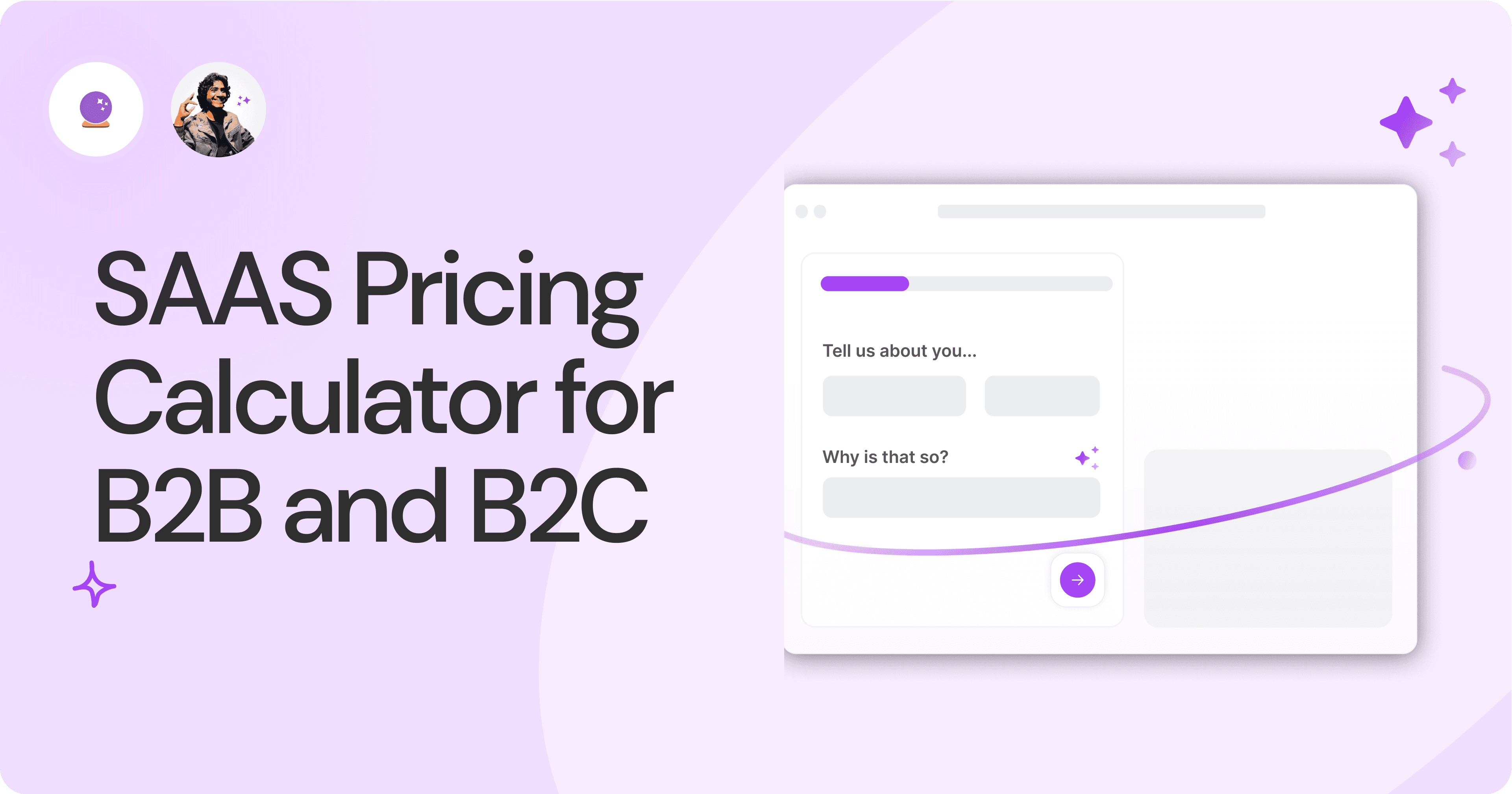
SAAS Pricing Calculators: B2B v B2C Online Forms.
The SaaS pricing calculator is an essential tool for both B2B and B2C SaaS companies. But how do you build it, right? We have you covered.
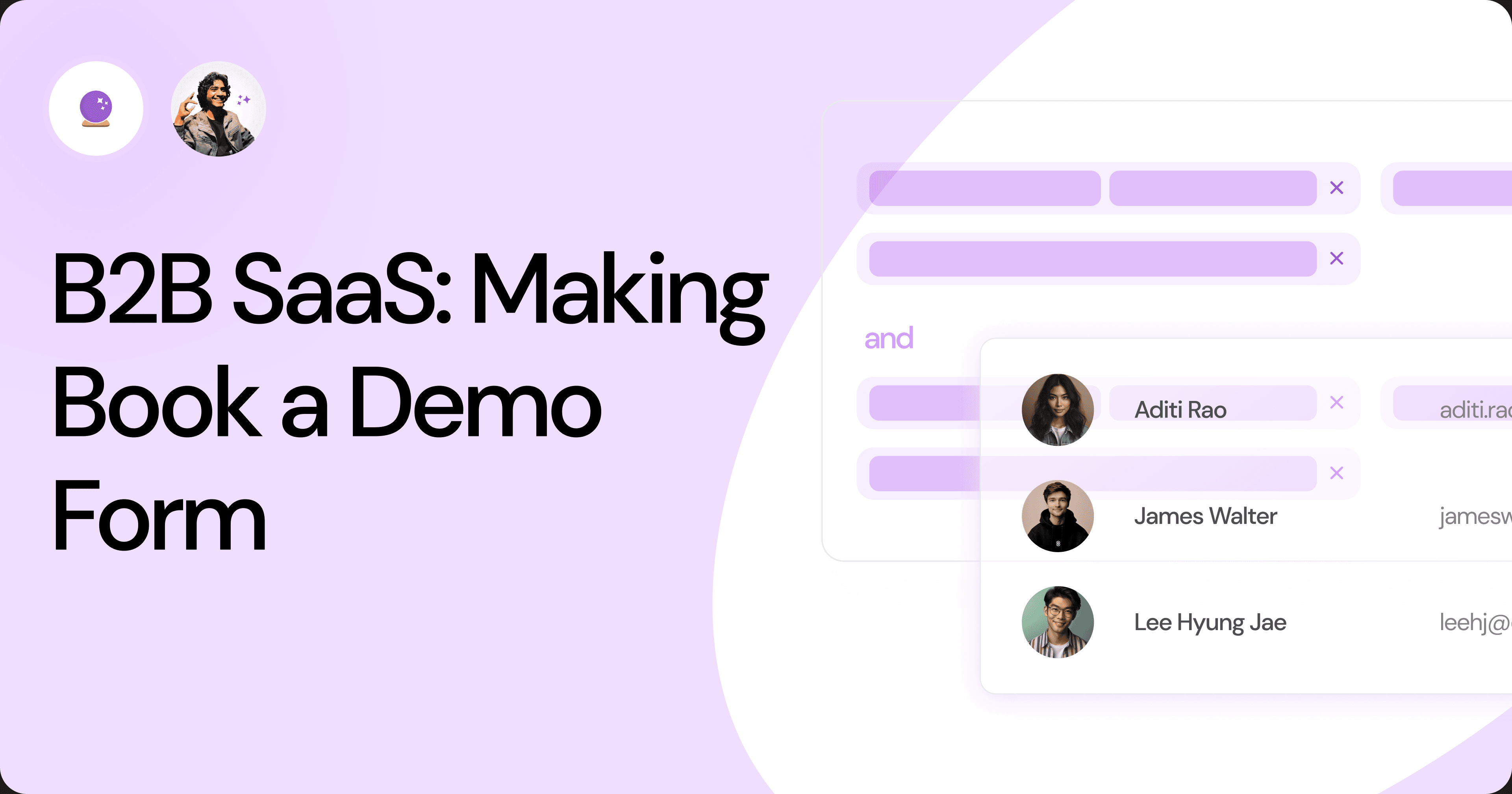
B2B SaaS: Making Book a Demo Form.
Having the perfect book a demo form for B2B SaaS is the first step in capturing leads. There are a few fundamental techniques to get this form right. Read on.

How to Get Started With SaaS Onboarding.
SaaS onboarding is essential for customer onboarding in B2B and B2C SaaS. Let’s understand its fundamentals, including the metrics.
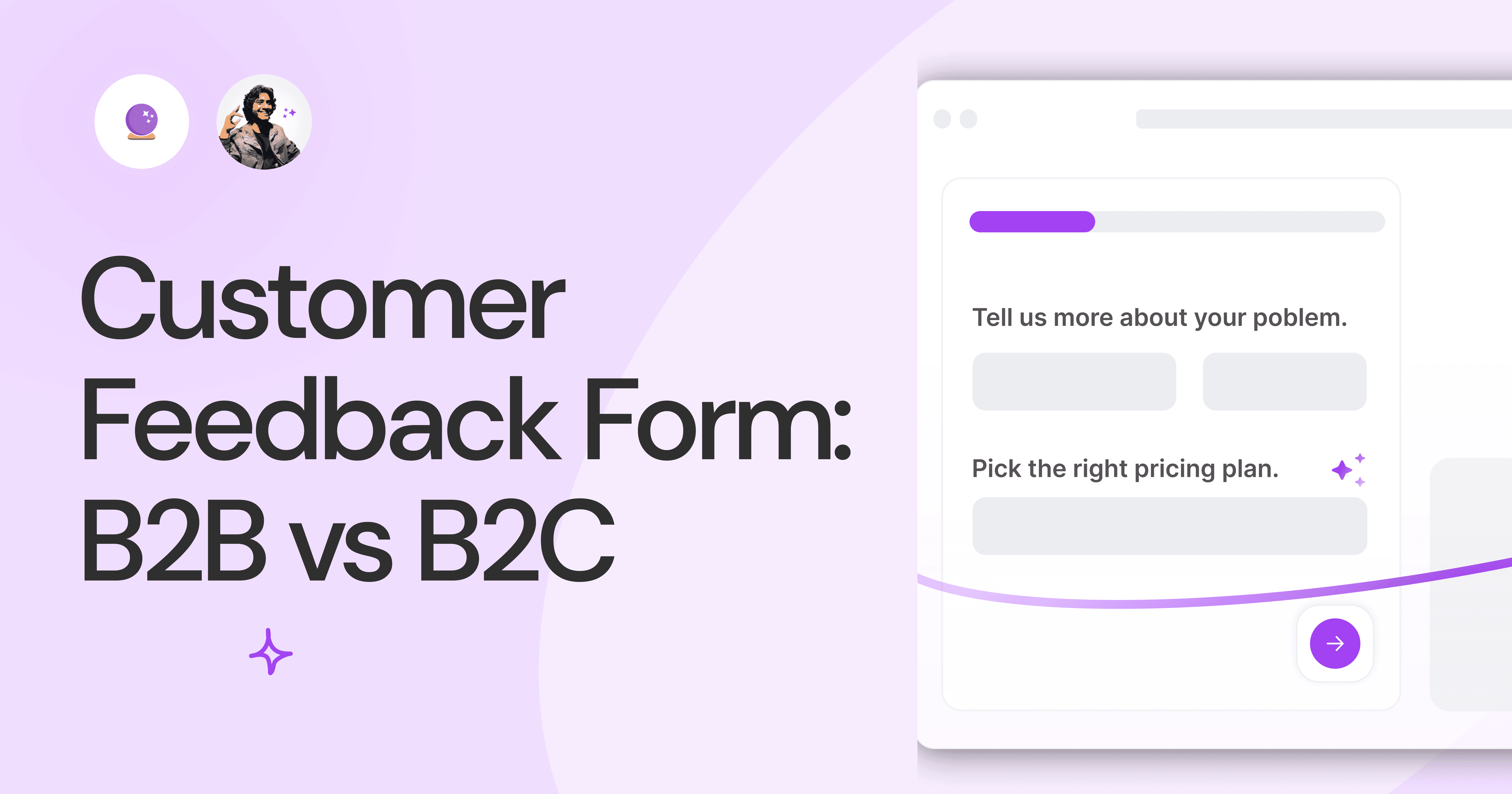
Customer Feedback Form: B2B vs B2C.
Why is customer feedback important? Because it dictates progress on B2B and B2B products and services for the customer to meet their goals.

SaaS Customer Feedback Form: 6 Main Types.
As much as SaaS is self-serve, the role of a customer feedback form is highly relevant. There are different types, each with its use case and sections.
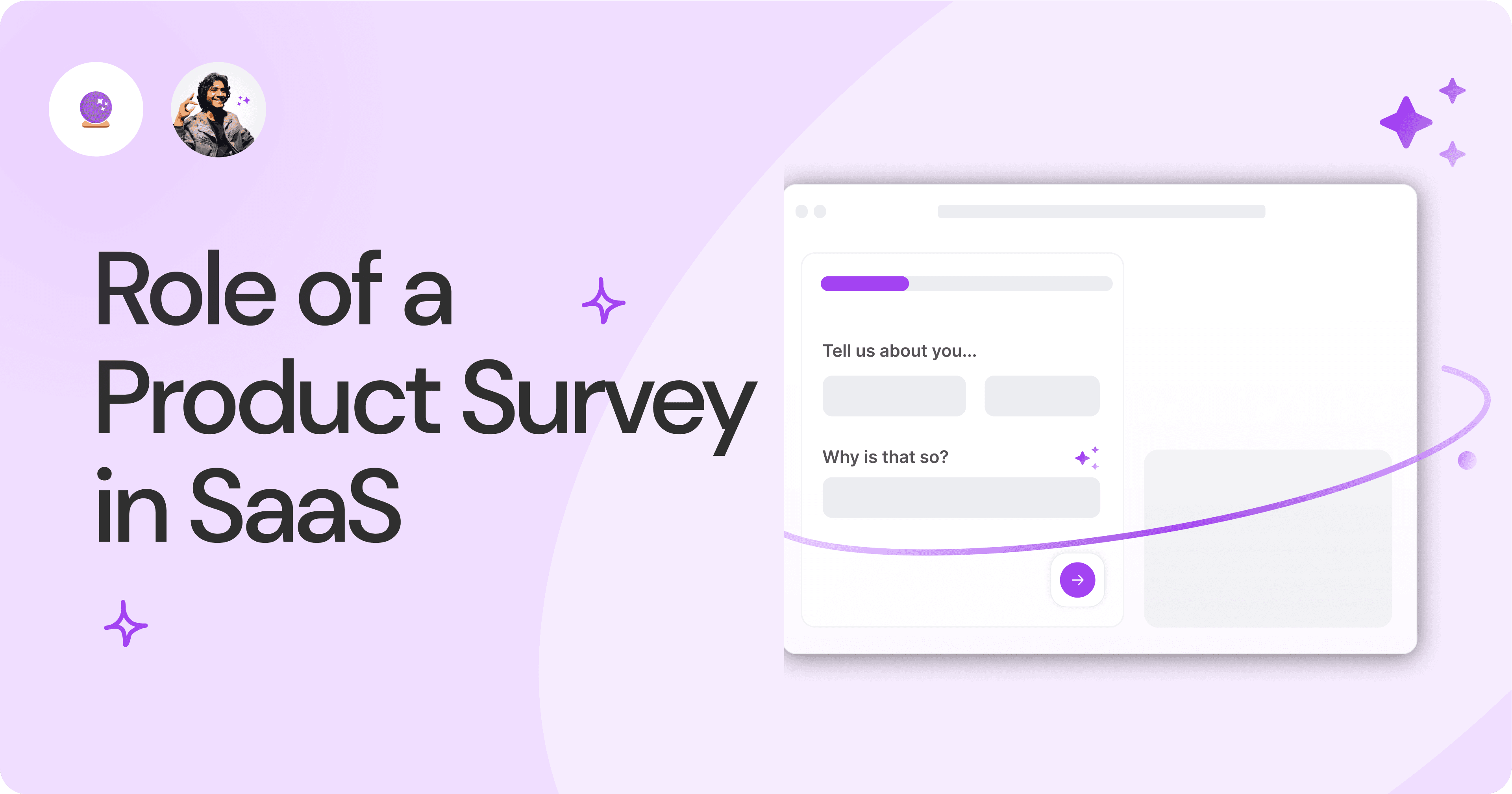
Role of a Product Survey in SaaS.
SaaS is all about creating products for specific use cases. This is where a product survey becomes all the more important to know the user deeply.

Should You Do a SaaS Market Survey?
Every SaaS company wants to grow fast. But without a market survey, growth isn't possible or sustainable. Let’s see how to do a market survey.

SAAS Pricing Calculators: B2B v B2C Online Forms.
The SaaS pricing calculator is an essential tool for both B2B and B2C SaaS companies. But how do you build it, right? We have you covered.

B2B SaaS: Making Book a Demo Form.
Having the perfect book a demo form for B2B SaaS is the first step in capturing leads. There are a few fundamental techniques to get this form right. Read on.

How to Get Started With SaaS Onboarding.
SaaS onboarding is essential for customer onboarding in B2B and B2C SaaS. Let’s understand its fundamentals, including the metrics.

Customer Feedback Form: B2B vs B2C.
Why is customer feedback important? Because it dictates progress on B2B and B2B products and services for the customer to meet their goals.

SaaS Customer Feedback Form: 6 Main Types.
As much as SaaS is self-serve, the role of a customer feedback form is highly relevant. There are different types, each with its use case and sections.

Role of a Product Survey in SaaS.
SaaS is all about creating products for specific use cases. This is where a product survey becomes all the more important to know the user deeply.

Should You Do a SaaS Market Survey?
Every SaaS company wants to grow fast. But without a market survey, growth isn't possible or sustainable. Let’s see how to do a market survey.

SAAS Pricing Calculators: B2B v B2C Online Forms.
The SaaS pricing calculator is an essential tool for both B2B and B2C SaaS companies. But how do you build it, right? We have you covered.

B2B SaaS: Making Book a Demo Form.
Having the perfect book a demo form for B2B SaaS is the first step in capturing leads. There are a few fundamental techniques to get this form right. Read on.

How to Get Started With SaaS Onboarding.
SaaS onboarding is essential for customer onboarding in B2B and B2C SaaS. Let’s understand its fundamentals, including the metrics.

Customer Feedback Form: B2B vs B2C.
Why is customer feedback important? Because it dictates progress on B2B and B2B products and services for the customer to meet their goals.

SaaS Customer Feedback Form: 6 Main Types.
As much as SaaS is self-serve, the role of a customer feedback form is highly relevant. There are different types, each with its use case and sections.

Role of a Product Survey in SaaS.
SaaS is all about creating products for specific use cases. This is where a product survey becomes all the more important to know the user deeply.

Should You Do a SaaS Market Survey?
Every SaaS company wants to grow fast. But without a market survey, growth isn't possible or sustainable. Let’s see how to do a market survey.

Nine Types of Healthcare and Medical Forms.
Medical forms are a must-have for any healthcare business or practitioner. Learn about the different kinds of medical and healthcare forms.

4 Tips for Better Medical History Forms.
Medical history forms are central to patient care, onboarding, and medical administration records. Learn how to make them easier to fill.

How to Build Mental Health Intake Forms?
Mental health intake forms are not like patient intake forms. Mental health intake forms deal with far more sensitive data and have specific design methods.

What, Why and How of Telemedicine Forms.
Telemedicine is on the rise and with different form builders out there, which one best suits your needs as a healthcare services provider?

3 Reasons for Major Drop-Offs in Medical Forms.
No matter which healthcare form we pick, there are major drop-off reasons. We shall dive into the top 3 and learn how to resolve them in your next form.

Patient Onboarding Forms - From Click to Clinic.
Patient onboarding forms are the first touchpoint for patients; getting this right for higher conversion rates is a must-have. Learn how to perfect them now.

5 Key Parts of a Good Patient Satisfaction Form.
The goal of patient satisfaction surveys is to course-correct the services of a healthcare provider. Patient feedback leads to a culture of patient-centric care.

Build Quick and Easy Medical Release Forms.
Every HIPAA-compliant healthcare provider comes across medical release forms that involve details from medical history forms. Can they be shipped fast? Yes.

SAAS Pricing Calculators: B2B v B2C Online Forms.
The SaaS pricing calculator is an essential tool for both B2B and B2C SaaS companies. But how do you build it, right? We have you covered.

B2B SaaS: Making Book a Demo Form.
Having the perfect book a demo form for B2B SaaS is the first step in capturing leads. There are a few fundamental techniques to get this form right. Read on.

How to Get Started With SaaS Onboarding.
SaaS onboarding is essential for customer onboarding in B2B and B2C SaaS. Let’s understand its fundamentals, including the metrics.

Customer Feedback Form: B2B vs B2C.
Why is customer feedback important? Because it dictates progress on B2B and B2B products and services for the customer to meet their goals.

SaaS Customer Feedback Form: 6 Main Types.
As much as SaaS is self-serve, the role of a customer feedback form is highly relevant. There are different types, each with its use case and sections.

Role of a Product Survey in SaaS.
SaaS is all about creating products for specific use cases. This is where a product survey becomes all the more important to know the user deeply.

Should You Do a SaaS Market Survey?
Every SaaS company wants to grow fast. But without a market survey, growth isn't possible or sustainable. Let’s see how to do a market survey.
Subscribe to stay updated.
Subscribe to stay updated.
Subscribe to stay updated.
HC

HC

HC

HC

70+ people from across industries read our emails.
HC

HC

70+ people from across industries read our emails.
HC

HC

HC

70+ people from across industries read our emails.




Bangalore, India / San Francisco, US
WorkHack Inc. 2023
Bangalore, India
San Francisco, US
WorkHack Inc. 2023
WorkHack Inc. 2023
Bangalore, India / San Francisco, US
WorkHack Inc. 2023
Bangalore, India / San Francisco, US



